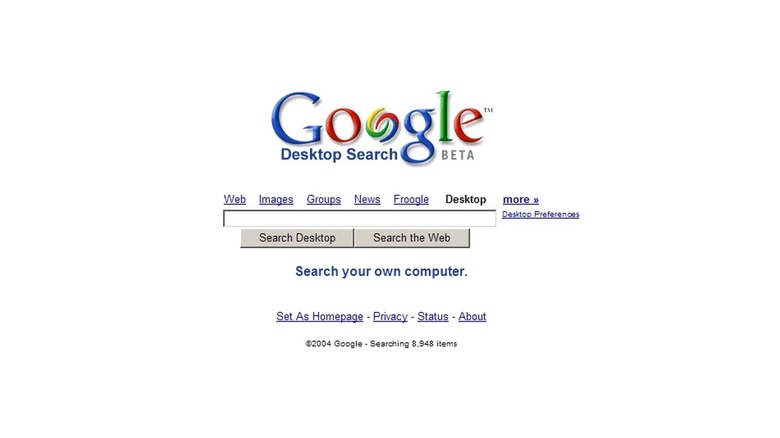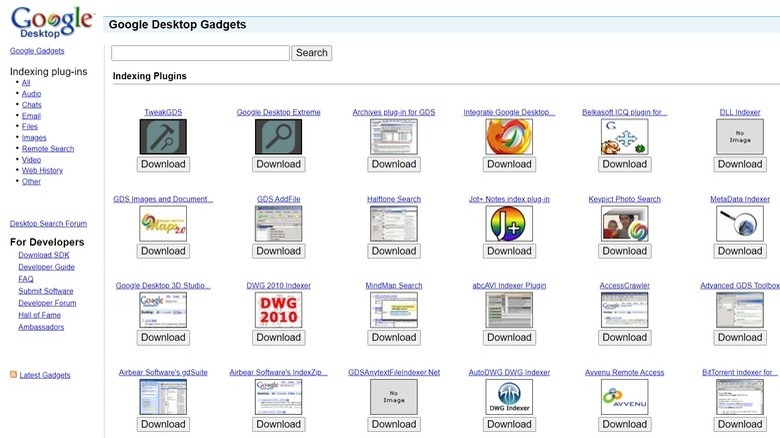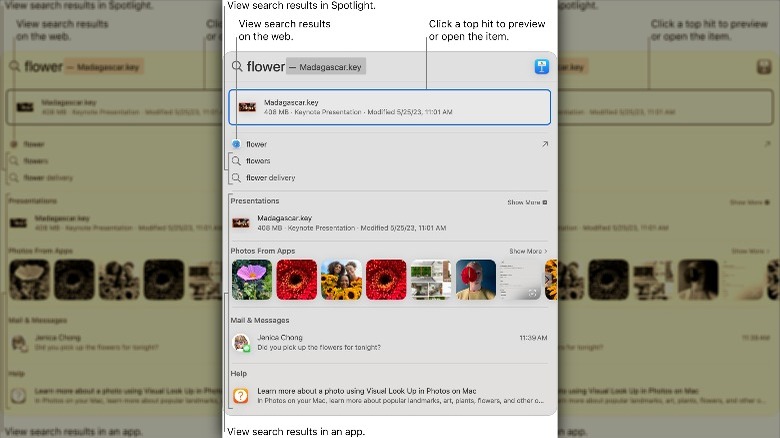Why Google Discontinued The Desktop App
Google's desktop app, called Google Desktop or Google Desktop Search, was introduced for Windows back in 2004. Three years later, the company released the app for Linux and Mac OS X. The Mountain View, California headquartered company has over the years gained a reputation for introducing products like experiments, because it has often taken the questionable decision to discontinue them soon after. Google Desktop was no different, because in 2011, just seven years after its introduction, the app was discontinued across platforms. Google also sunsetted nine other products and services in what it called a "fall spring-clean," detailing the reasons for discontinuing each of them.
The company's rationale for doing away with Google Desktop included changes in the way people stored and accessed their data since its launch, making the app redundant. Google Desktop was meant to augment the operating systems it was offered on, and its features included more than just the ability to quickly perform web searches from the desktop. The app also allowed users to search for files on their computers, as well as chats and emails.
With over 30 years of experience using PCs, on a variety of operating systems, and nearly half that time as a tech journalist, in this article I'll share my perspective of how computing evolved from the days before Google Desktop to the present day. Providing this context to readers should clarify why Google stopped developing the app, instead choosing to concentrate its resources on existing products and other development.
What made Google Desktop useful?
When first launched in 2004, Google Desktop was a web app, specifically an Internet Explorer — the legacy Microsoft browser retired in 2022 — add-on, called Google Desktop Search. Over the years across platforms, it let you search cached webpages from browsing history, local files (including cached/deleted files), various chat apps (including AOL Instant Messenger), and emails within certain clients. A search on Google.com would deliver desktop results on top. The Sidebar brought Google gadgets like scratch pad notes, news, weather, and stocks. Also useful was the Quick Search Box, and a Deskbar or Floating Deskbar .
Google Desktop was very useful in Windows XP and Windows 2000 SP3, as there was no built-in search in these operating systems. Microsoft didn't introduce system-wide search until Windows Vista in 2007, and even that didn't look within chats and emails. Google Desktop let users search for files, programs, folders, emails, chats, webpages, and even web-based results, all from a single place. It introduced desktop widgets before Windows, and even had an API for third-party gadgets.
It's a slightly different story for Mac, where both Spotlight search and Dashboard gadgets were introduced with Mac OS X v10.4 Tiger in 2005. The only advantages in using Google Desktop were the third-party email search, and being able to perform a web search from the desktop. Linux on the other hand had no built-in search features beyond command line functions.
What made Google Desktop redundant?
Google, in its blog post announcing the discontinuation of Google Desktop, said that in the years leading up to its decision, there had been a general shift away from local storage and computing, toward cloud-based offerings including web apps. This was perhaps in part due to the trend toward mobile computing devices, such as laptops and smartphones, away from their more powerful desktop brethren. The company also pointed toward the improvement of operating systems, which by that time started offering native search and widget functions. With the adoption of solid-state storage, non-indexed search was also much faster, and offline caching of cloud storage — including native offerings like OneDrive and iCloud — allowed for easy access to data regardless of internet connectivity.
Thus, with improvements in computing, cloud storage, and integrated functionality in operating systems, it became obvious that Google Desktop was becoming a redundant offering, and its continued development no longer made sense. Google instead decided to use its resources developing other products and services that would have greater adoption. Other products discontinued by Google during the same September 2011 "spring-clean" included Fast Flip (a news reading interface), Google Pack (a bundle of Google apps), Google Web Security, Google Notebook, and Sidewiki (a sidebar for user comments about websites).


